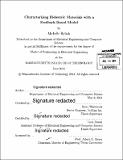Characterizing dielectric materials with a feedback-based model
Author(s)
Rybak, Michelle (Michelle A.)
DownloadFull printable version (5.999Mb)
Other Contributors
Massachusetts Institute of Technology. Department of Electrical Engineering and Computer Science.
Advisor
Scott Westbrook and Luca Daniel.
Terms of use
Metadata
Show full item recordAbstract
As signal frequencies continue to increase, conductor surface roughness losses of interconnects are becoming more prominent. There is currently no industry standard for separating the dielectric and conductor losses that appear in PCBs. As part of the thesis work, test vehicles composed of six different dielectric materials were fabricated with different trace widths, copper foil profiles, and oxide surface treatments. A Feedback-Based Model was used to simulate and extract the dielectric and conductor losses from measurements made with the different test vehicles. Simulation software such as MATLAB, Agilent ADS, and Polar Si9000 were utilized. Dielectric material Megtron 4 had the lowest Df of the materials of interest. The Feedback Based Model was able to fit the data well for either low frequencies and high frequencies, but not both. Further, the model was able to model the effects of changes in copper roughness well. Small variations were seen in the extracted Df associated with changes in width of the measurement traces.
Description
Thesis: M. Eng., Massachusetts Institute of Technology, Department of Electrical Engineering and Computer Science, 2014. Cataloged from PDF version of thesis. Includes bibliographical references (pages 54-55).
Date issued
2014Department
Massachusetts Institute of Technology. Department of Electrical Engineering and Computer SciencePublisher
Massachusetts Institute of Technology
Keywords
Electrical Engineering and Computer Science.